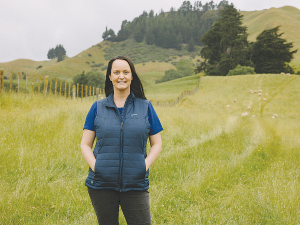Rabobank 2026 Outlook: Geopolitics shapes global agriculture
The global agricultural landscape has entered a new phase where geopolitics – not only traditional market forces – will dictate agricultural trade flows, prices, and production decisions.
 Emma Higgins, RaboResearch, believes a royal flush of opportunities lies ahead for the primary sector in 2025.
Emma Higgins, RaboResearch, believes a royal flush of opportunities lies ahead for the primary sector in 2025.
Following several years of pain, farmers and growers are facing a decent upswing in commodity prices, say economists.
The good news isn't restricted to the pastoral sector - horticulture exports are also rising.
RaboResearch senior agricultural analyst Emma Higgins points out that following several years of challenging market dynamics - high input costs, interest rates, and lower farmgate prices - New Zealand agricultural producers look set to be dealt a "significantly improved hand" in 2025.
"The 2025 'deck' looks much improved for New Zealand agricultural producers, providing a relatively strong hand for the year ahead," says Higgins.
"While there are a couple of 'wild cards' and 'jokers' to navigate, all in all, we think the deck is stacked in the sector's favour and, if we play our cards right, a royal flush of opportunities lies ahead for the sector in 2025."
A contraction in beef numbers globally alongside strong demand from the US is likely to build upon an already strong pricing base for this year and beyond for New Zealand beef, notes Higgins.
"Dairy producers are also likely to see balanced market dynamics in 2025, supporting record nominal farmgate pricing forecast for the 24-25 season.
"Sheepmeat, the laggard of the bunch of late, has kicked off 2025 with lamb prices nearly $2/kg ahead of last year. Aussie sheep numbers are finally dropping and good demand from the UK, EU and US has underpinned recent returns. And, if Chinese demand for mutton picks up, we could be looking at a 'full house' for farmgate prices across our major agri export sectors."
While sheep farmers may not be celebrating yet, BNZ senior economist Doug Steel says the recent 41% gain in the price of a leg of lamb will be welcomed.
Steel notes that there has been a decent upswing in global prices for some of NZ’s major primary export products over the past year. For example, wholemilk powder prices are up 18%, the price of a leg of lamb is up 41%, and the US imported bull beef price is up 24%.
“Such gains will be welcomed by domestic producers and those directly connected to primary sector returns alike. To be sure, not all primary prices have performed as well and some of the price gains have been off previously very low levels (like lamb), but they still represent a significant improvement from year-ago levels.
“It offers material support to the prospect for export returns for the current season’s produce relative to the previous season.”
He says the positives have not been restricted to the major pastoral sectors. Horticulture export returns have also stepped higher.
“Latest figures show horticulture exports in 2024 were 31% higher than in 2023. This was driven by kiwifruit with a hefty gain of 44% while apple exports rose 14%.
“These gains were buoyed by the season’s bumper production volumes, which was a major change from the previous cyclone-affected season,” says Steel.
Dairy continues to be a star performer. Last week’s 4.1% in whole milk powder prices takes the flagship product’s price to US$4169/tonne – the highest price in nearly three years.
Westpac’s industry economist Paul Clark says dairy’s market price outlook remains favourable.
He says WMP has led the recovery, reflecting a greater buying presence from Chinese and European buyers and lower offer volumes.
“Increased Chinese purchases reflect efforts to rebuild previously run-down inventories, especially ahead of the Chinese New Year,” Clark says.
He notes that Westpac’s forecast milk price for the season – the same as Fonterra’s forecast milk price midpoint of $10/kgMS – could rise.
“Our milk price forecast assumes lower average dairy prices over the remainder of the 2024/25 season. That in turn assumes the rebuilding of dairy inventories in China winds down.
“However, should the rebuild continue at current pace, that is likely to sustain or push dairy prices even higher, implying an upward revision to our milk payout forecast.”
Bradley Wadsworth lives on the family farm – Omega Station – in the Wairarapa about 30 minutes’ drive east from Masterton.
With global milk prices falling, the question is when will key exporting countries reach a tipping point where production starts to dip.
Rural contractors want the Government to include a national standard for air plans as part of its Resource Management Act reforms.
The biggest reform of local government in more than 35 years is underway.
An industry-wide project led by Ministry for Primary Industries (MPI) is underway to deal with the rising number of feral pests, in particular, browsing pests such as deer and pigs.
Three New Zealand agritech companies are set to join forces to help unlock the full potential of technology.

OPINION: Winston Peters has described the decision to sell its brand to Lactalis and disperse the profit to its farmer…
OPINION: The Hound reckons a big problem with focusing too much on the wrong goal - reducing livestock emissions at…